Walking the Path
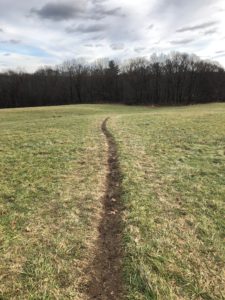
WALKING THE PATH
On a cold, clear, windy, late November day last week, I visited Andover, Massachusetts, where, during the ‘Great Delusion of 1692,’ forty-five women and men residents were accused of being ‘witches,’ arrested and imprisoned, including my 8th great grandmother, Mary Clements Osgood.
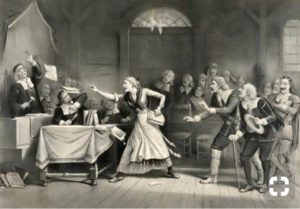
Mrs. Mary Clements Osgood, center
Since a young girl, I enjoy walking awhile in the paths my ancestors’, their friends, and ‘enemies’ traveled. Mary’s is certainly one, but I find many stories interesting, and connected – branching from one to the other.
With the aid of preserved letters, documents, photographs, paintings, and other historical information, I travel back in time, so to speak, acquiring knowledge about what they endured, enjoyed, where and how they lived, traveled, and whom they loved. In many ways, to me, learning about them is like doing a puzzle and playing a detective game. The end result – the prize – a window into the past, often colorful, like stained glass.
In Andover, more women and men were accused and arrested under the idea that they were ‘witches’ than in either the town or village of Salem, yet on that day, I didn’t go to Andover thinking of them or Mary. But as is often the case, one track led to another.
I was thinking of Mary’s husband, my 8th great grandfather, Captain John Osgood, born in Wherwell, Hampshire, England in 1631. At age 7 in April 1638, John sailed to America with his father (also named John), mother, Sarah Ann Booth (Osgood), and younger sister, Mary, on the ship, Confidence, landing in Ipswich during the month of June. After a quick stay there with emigrant (1633) and relative, Christopher Osgood, John settled his family for three years in Newbury until he moved them to a settlement called Cochichowicke (Great Water) which he named Andover, for his home town marketplace ‘across the pond.’
John Osgood built his home on the banks of the river, today at the junction of Osgood and Court Streets. He came to own 600+ acres of land, in what now is North Andover. His barn, on the east side of Osgood Street, still stands, along with his second home, on the National Register of Historic Places.
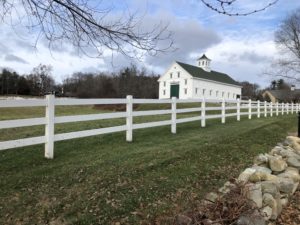
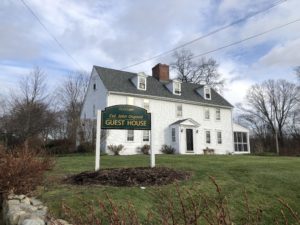
Surrounding both is land he called “Great Wide Meadow,” as referred to in 1690s’ deeds, including a long, sweeping hill then called ‘Weir Hill’ with views of the valley and lake. Of recent, the hill is named Osgood Hill, now public paths and wooded areas for the public to enjoy and roam. Edgewood, An Independent and Life Care Community, sits on 100 acres of John’s original land (including John’s original 1600’s barn and original house, now a guest house for visiting families) with Osgood first names marking street signs and mailboxes.
Finding out about John, I then wanted to know more about Mary. Born in Ansley, Warwickshire, England in 1637, her father was Reverend Robert Clements, a prosperous English wine merchant living at Croft, near Leicester city. During the 1620s and 1630s, Clements owned a fleet of ships which sailed between North America and England. During a shipwreck, his brother, John, lost his life.
When Mary’s mother, Lydia, died in March 1641, when Mary was four, her oldest brother, Job, seems to have traveled to New England, and along with ten others, settled Haverhill, Massachusetts. He soon asked their father to sell his English estate and join him. Clements did, emigrating with four of his eight children, leaving Mary, the youngest, in England, perhaps with grandparents, and two sons fighting in the English Civil War (they would eventually earn land grants and live in Ireland). At about 5 years of age, Mary re-joined her father, in New England.
Reverend Clements remarried in 1645, in Haverhill and on November 15, 1653, in the same town, performed the marriage ceremony of Mary and the young Captain John Osgood, age 20. Mary was 16.
While John volunteered service to the militia (30 years total), helped found North Parish Church, and became the first representative to the General Court of Andover, Mary gave birth to twelve babies (yes, twelve!). The couple buried two within the first year of birth, another two within a year and a half, the twelfth and last, just a month old, when Mary was about 54 years old. Eleven years later, in regards to that dark period of time in Mary’s life – the loss of her baby at age 54 – Mary would be accused by rivals of having performed ‘witchcraft.’
At age 65, along with fellow neighbors and friends, Mary was “examined” in Salem before John Hawthorne and other “Majestie’s Justices.” On September 8, 1692, after being “brow beaten,” Mary confessed to the incident below and indicted in January 1693. Recanting before Increase Mather, a powerful Puritan clergyman and president of Harvard College, Mary was imprisoned in Salem.
From the Salem Witch Trials Documentary Archives and Transcriptions:
The examination and confession (8. Sept. 92.) of Mary Osgood , wife of Captain Osgood of Andover, taken before John Hawthorne and other their Majesties justices:
She confesses, that about 11 years ago, when she was in a melancholy state and condition, (following the birth of her last child) she used to walk abroad in her orchard; and upon a certain time, she saw the appearance of a cat, at the end of the house, which yet she thought was a real cat. However, at that time, it diverted her from praying to God, and instead thereof she prayed to the devil; about which time she made a covenant with the devil, who, as a black man, came to her and presented her a book, upon which she laid her finger and that left a red spot…
Rev. Increase Mather’s Report of his Conversation in Prison with Mary Clements Osgood:
Being asked why Mary prefixed a time, and spake of her being baptized in The Great Pond, &c., about twelve years since, she replied and said, that, they asked the time, to which she answered that she knew not the time. But, being told that she did know the time, and must tell the time, and the like, she considered that about twelve years before (when she had her last child) she had a fit of sickness, and was melancholy; and so thought that that time might be as proper a time to mention as any, and accordingly did prefix the said time.
Being asked about the cat, in the shape of which she had confessed that the Devil had appeared to her, &c., she replied, that, being told that the Devil had appeared to her, and must needs appear to her, &c. (she being a witch), she at length did own that the Devil had appeared to her; and, being pressed to say in what creature’s shape he appeared, she at length did say that it was in the shape of a cat. Remembering that, some time before her being apprehended, as she went out at her door, she saw a cat, &c.; not as though she any whit suspected the said cat to be the Devil, in the day of it, but because some creature she must mention, and this came into her mind at that time.
“Stripings” of many, death awaiting execution, and the public hangings of approximately twenty women took place over a period of time. In regards to those from Andover, three persons were hung and one woman died before execution. Many of the girls, women, and men (mainly women, yet one girl as young as 4, who was executed) were accused of having “fits,” unable to control their muscles, privately and in public. Since the 1970s those ‘fits’ have believed, by some, to have been hallucinations caused by the ingestion of a common grain, poisoned naturally with a fungus; ‘ergot poisoning’ having effects much like that of LSD.
After some time, Mr. Dudley Bradstreet, Andover’s Chief Justice, who had issued the warrants and arrest of forty-eight suspected “witches,” finally refused any more. Bradstreet petitioned for the release of Mary and others (after which and for, he and his wife were themselves accused of being ‘witches,’ and fled North Andover for their lives). After four-six months in prison in Salem, Mary was released, with four other women. Bradstreet had, for all his weaknesses previously, saved them.
Learning more of Mary’s story, I contemplate her admittance that she experienced ‘melancholy’ after the birth of a child. Today this most certainly would be understood and accepted as postpartum depression, thought by many doctors to be caused by a copper overload. Sympathizing with Mary has made me appreciate and better understand the time she lived and imagine what she went through.
One of Mary and John’s children – my 7x great grandfather – Lieutenant John Osgood, born 1654, also spent time in prison. Active in the militia, an inn holder and serving frequently as selectman, he was popular among the townspeople of Andover, mainly due to his opposition of England taxes. He was imprisoned in August or September 1687, five years before Mary was accused of being a witch. Mary and John eventually left him their house, where the first recorded town meeting was held in March 1656.
In previous visits to North Andover, I have seen that house (today the guest house at Edgewood). I have also driven by the historical home at 440 Osgood Street, that of Samuel Osgood, who, three generations after Mary and John, was an American Revolutionary War colonel, First United States Postmaster General, and member of Continental Congress. His home housed Harvard’s library during the war against England.
A new house I discovered, however, upon this visit to Andover, after being given the address by the Executive Director at the North Andover Historical Society, was the address of my 5th great grandfather’s house, numbered 815 Osgood Street. I found the colonial – about a mile from the Colonel John Osgood House. Red in color, a sign to the left of the doorway read “Dr. Joseph Osgood, 1752.” (His father, my 6th gg, another John Osgood, born 1683, Deacon and Lieutenant of Militia, his wife, Hannah Ayres (Osgood) of Haverhill, born 1662).
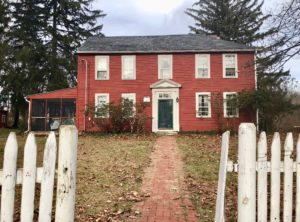
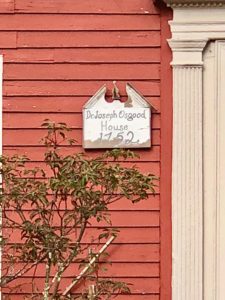
I parked my car in front of the white picket fence, in need of painting, and got out, to stand before the open gate leading up the brick walk to the front door. Though I was disappointed at the unkempt condition of it, being in its presence for the first time felt very special.
I envisioned my 3rd great grandmother, Sarah Vose Osgood (Tracy) – Dr. Joseph Osgood and wife Margaret’s youngest grandchild – born April 1804, running up the path to the door, anxious to greet her grandparents, and they her. Perhaps, after they opened the door, they bent down and wrapped their arms about her as they picked her up to a hug, with the aroma of a Sunday supper wafting from the kitchen fire.
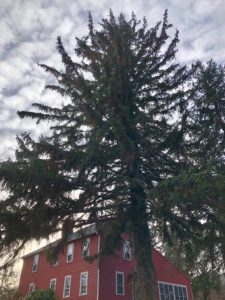
Sarah’s photograph and diary of 1862 were thankfully preserved. Sarah’s father – my 4th great grandfather – George Osgood, was also a doctor, like his father, whose house I now stood in front of, had been. Her mother, Sarah Vose, daughter of Colonel Joseph Vose of the 1st Massachusetts Regiment who fought alongside George Washington during the American Revolution, was born in Milton. She’d had a baby at 42 years of age and died when Sarah was eight years old, at age 50 of tuberculosis, or “consumption.”
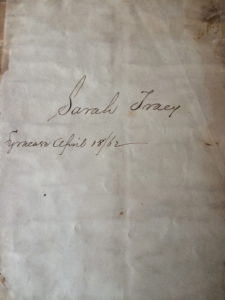
Standing there at Dr. Joseph Osgood’s house, I had just exited my warm car but not having worn a warm enough jacket, shivered. I contemplated what life must have been like, in the early 1800s. Considering a fall, winter, or spring day and night, and New England weather, the house inside would have have been cold – very cold.
The family would have gathered around the one fireplace – talking, reading, studying, playing music, etc. Babies would have been born in the bedrooms and died there, too. Without antibiotics, children often died of diptheria.
Joseph and Margaret, like Mary and John, and so many couples, lost numerous children, specifically they lost three sons, age @two and one age 14 ten months, the graves of which I would later see that day. Losing all those children might have been enough to kill my 5th great grand mother (or make her, like Mary Clements Osgood, delusional) but Margaret lived until 1797, to age 78. Fortunately, the third child, born in 1754, another John Osgood, would live to see adulthood and old age.
Remnants of what might have been the outhouse was a helpful reminder that there had been no running water and of course, no electricity. I considered what the Osgood father and son doctors must have seen in their lifetimes, practicing generalized medicine in the late 18th and early 19th centuries. They would have visited most homes in town, to doctor babies, children, women, and men for all different reasons.
Suddenly, bringing me back to the present, was the current owner or renter exiting the back door to his parked car in the driveway. I soon got back in my car but sat a time thinking about how my 3rd great grandmother, Sarah Vose Osgood Tracy, lived in North Andover until her later twenties when she moved to Syracuse, New York.
Sarah left the only home she’d known with her older half sister, Elizabeth Osgood (Putnam) and Elizabeth’s husband, Captain Hiram Putnam of Salem who had been commissioned by the wealthy Boston merchant, Joseph Peabody, to captain ‘The China’ twice around the world trading coffee, tea and spices. He later wrote he felt “ready to get away from the sea.” Ironically, Hiram’s male Putnam ancestors, of Salem, and the Peabody’s, were lead accusers in the witch craft movement.
Though Sarah moved away, during her 97 years of life she often reminisced upon her beloved North Andover. Suggesting that, along with many preserved letters, is a poem, below, written for her 93rd birthday by her nephew, George Osgood, giving insight into the beauty of the land and the love the Osgood generations held for it.
After leaving Massachusetts and arriving in Albany, Sarah met her love, James Grant Tracy, whose father, Captain Jared Tracy of Norwich, CT, was a commissary during the siege of Boston and later fought the enemy at sea. Sarah and James married and resided in Syracuse, where they lived the rest of their lives, though Sarah as a widow when their oldest son, James Grant, was 13.
This part of Sarah’s story I am familiar, for I have been engrossed in it my entire life, through letters, stories and memorabilia which my maternal grandfather, John Bayard Tracy, shared with me while I was growing up in Syracuse, in Sedgwick Farm. As a single parent, Sarah raised four sons, losing the youngest to diptheria within the same year of her husband’s death. Two of her remaining three sons’, Osgood and William, volunteered to fight in the American Civil War.
In Syracuse, I knew Osgood’s daughter-in-law, my great grandmother, Florida Bayard Tracy, who lived until I was ten years old. For that reason, to me, as a young girl, the past didn’t seem so long ago. I was amazed that I knew “Granny Tracy” whose father-in-law had fought in the Civil War for the North and father, Captain John Seay, and two bothers from Rome, Georgia for the Confederates, then some 110 years before.
At present, I understand better what my grandfather once shared and documents and books indicate. Having lived in Boston now more than half my life – the last 15 years on the North Shore of Boston, a 35-minute drive to Andover and 15 minute drive to where the Confidence arrived in Ipswich with my Osgood emigrant ancestors -it is part of my journey in adding to the puzzle, walking on and extending the path.
Ironically, twenty-five years ago, while living in Boston, I chose Andover to shop for and purchase my wedding dress, with my mother by my side. I chose it knowing our family history there, but not to the extent I know now or appreciate. While standing there last week in front of my 5th great grandfather’s house, I felt full circle – my past tied to my present, and future.
*
When I got back in my car, I cranked up the heat, put the car in drive and headed down Osgood Street, about 1/4 mile. I turned left, winding up a steep hill into the Steven’s Estate at Osgood Hill. At different times during the 1700 and 1800s, Osgood’s and Steven’s married. The red brick mansion and grounds are now owned by the Town of N. Andover, used for special functions.
Proceeding at the top, by the house, designed by prominent Boston architects and built in 1886 for Moses T. Stevens, an American textile manufacturer and a U.S. Representative from Massachusetts, I parked at the carriage house.
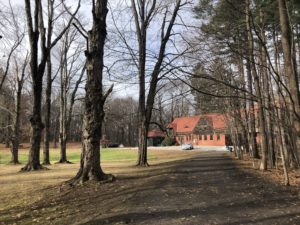
Heading to the trailhead of Osgood Hill, paths extend in three different directions.
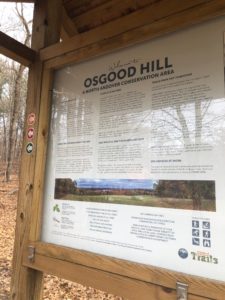
I first walked to the right, to a private drive, at the end of which might sit Sarah’s childhood home, now a private home, with magnificent views overlooking “The Great Meadow” and beyond, to the Colonel John Osgood Guest House and original barn, and Edgewood.
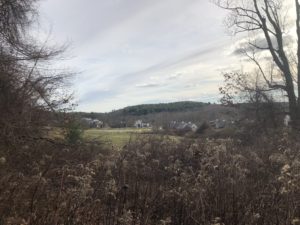
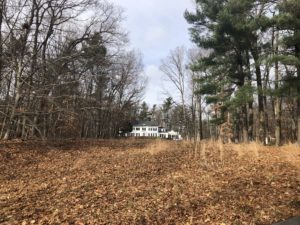
Walking back to the trailhead, I then took the path to the left, wrapping around Osgood Hill at its lower point. With woods on either side of the Hill, it reached the East side, with views extending through down the valley to Lake Cochichewick, which the Osgood’s called “The Great Pond.”
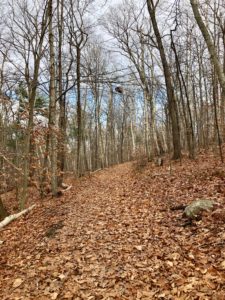
Among this path, where generations of Osgood’s roamed, Mary Clements Osgood, accused of and stating under duress, spent time, including that which when she was, as she stated in trial, ‘re-baptized by Satan,’ in its’ water with her friends. I couldn’t help but wonder whether, on a warm, late spring or summer day, Mary and/or they were just having fun, like I might today with my friends and neighbors.
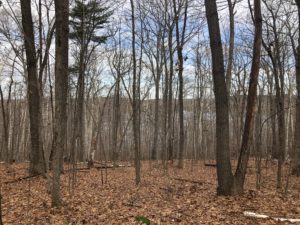
Perhaps a young man joined them, a man Mary described as a “Black Man,” and during trial, under verbal and physical abuse by the “Justices” at Salem, she referred to him as “Satan.” Mary’s great grandfather, less than a hundred years later, would allow African Americans and women as members of North Parish Church long before other New England churches did, and 80 years after that the Osgood Tracy brothers would go to war to end slavery…
With the majority of the leaves off the trees, a clear view presented through to Lake Cochichewick, “The Great Pond.” White birch trees and Oaks interspersed the woods, standing and covering the ground, causing a lightness and brightness to the dense forest. Original stone walls ran from the top of the Hill from the original estate, now private (at the end of the private drive I’d walked from the first path, perhaps the very house in which Sarah spent her childhood, yet another stone to turn) down toward the lake.
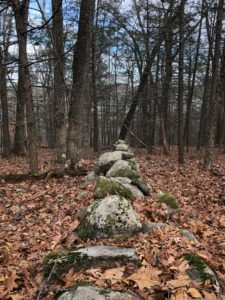
After a ten minute walk, the path opened to the wide lawn of green grass, to Osgood Hill (once Weir Hill) and a breathtaking view of sky and tree line. In my opinion, whether intertwined to this property through ancestors or not, you can not help to take in its natural beauty and feel connection to the land.
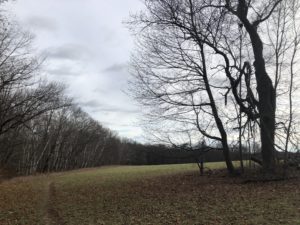
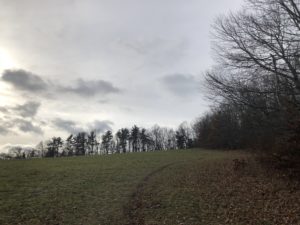
The wind rattled the dry leaves still clinging to the branches. Hawks circled overhead. Though it was my second walk on Osgood Hill ever, and the second time within this year, it felt more special even than the first. I felt closer to the past, like it was swirling with the brisk air.
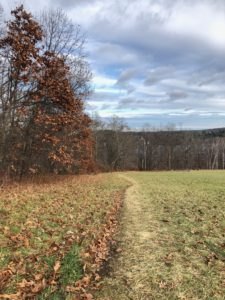
I followed the worn path amongst the green grass and reached the top of Osgood Hill, looking back from where I came. I took in the panoramic views. The lake in the distance sparkled in the sun, shooting through the clouds. The white birch trees stood at its shore’s edge, mixed among the others, the grass on the Hill was still green, with small patches of snow here and there, and the sky spread to the horizon.

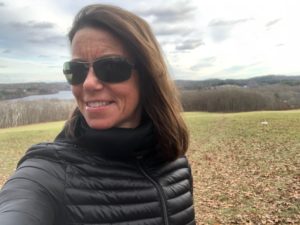
When it was time to go, I followed path markers into the woods at the top of the hill, at its’ highest point, enjoying the quiet of the woods, imagining, generations ago, my ancestors walking right there too.
But as the path became less marked, which would connect to the trail below, and being alone, I decided to head the way I arrived, down the hilly meadow, to circle the lower path, just above the lake.

Back to the Steven’s Estate and at my car, I drove out back down hill, to Osgood Street and headed to the First Burial Ground in N. Andover, in “The Great Meadow.”
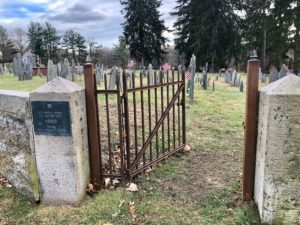
I entered the wrought iron gate just as a school bus about a 1/4 mile away dropped middle grade or elementary students off, with the sound of the children laughing and happy to be dismissed. As I stood by the Osgood gravestones, the boys, wearing their backpacks, were soon hopping over the stone wall, cutting through the old, historic cemetery. I imagine, from the surprise of them seeing me, that it is a daily occurrence, one which I found beautiful and touching – the incongruence of life and death connecting, and a reminder that life goes on.
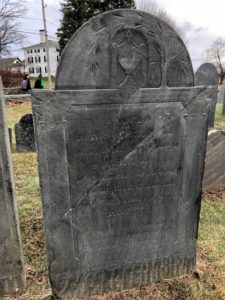
I would say, in ending, that I now certainly have a better understanding of the terrible injustices of, mass hysteria and cruelty, and broad area besides Salem affected by the witchcraft movement, reminded of what I learned in middle or high school that I had forgotten. I look forward to researching.
And in looking back at these numerous past generations, I am humbled by the experience. What I have discovered this past week and over the years, is that life, though different then and always changing, was still similar in so many ways and perhaps will always be.
Walking awhile in my ancestors, their friends and neighbors footsteps helps me to find and appreciate my own, and others. It not only shapes me, but inspires me, and in general, keeps me learning. It gives me a sense of who I am, who came before me, and what I want to accomplish.
Through the process and in life in general, I have found that some paths are smooth, others rough, some unmarked, many not straight. These stories above, and others, attest, paths can swerve. Change. End. And during our journey on the path of life, many people and places guide us, offering or giving direction, especially in our early years. When children, we often do not have the option of following which path we might choose for ourselves. As we grow older, we have more power of choice, though often time and/or commitments keep us going in one direction, often as if with blinders on.
Yet at any given point, new paths might branch off, and in changing direction, for want or not, we may find, that along with the path, our very selves and souls widen too.

Poem for Sarah Vose Osgood Tracy, written in 1897 for her birthday by her nephew, George Osgood:
A noble, Syracusan dame,
Whose years are only ninety-three,
The distant home from whence she came,
Today, in thought, would truly see.
As she in memory wanders back
Through pleasant scenes of long ago,
She views her native Merrimack
By hills and valleys grandly flow.
Again she trips with girlhood’s feet
Along the bank of vernal green,
Where, with the broader river, meet
The waters of the fair Shawsheen.
The Pond among its groves and hills,
Beneath the radiant sunset sky,
Again her heart with rapture thrills,
While joy and gladness light her eye.
The “China” down by Salem shore,
With sails all spread, she still would see,
Which long through calm and tempest bore
The hero noble, brave and free.
The hero left the ocean tide
With those whose lives her own endear;
And lived by Onondaga’s side
For many a long and happy year.
O what romantic feelings wake,
As she delighted rides away,
By wild Oneida’s lovely lake,
To spend her sweetest, happiest day.
Though she may love to muse awhile
On scenes where she delights to roam,
She better loves the gentle smile
Of one who cheered and blest her home.
The father and the little child
Must sweet remembrance bring today,
As they in love and beauty smiled,
Ere from the earth they passed away.
Her loved ones who have gone before,
A down the valley, dark as night,
Will gladly find the other shore
Aglow with heaven’s unclouded light.
The boys’ who bravely left her side
When bugle notes were loud and clear,
Through the sad fields of war to ride,
Today are grouped beside her here.
These sons will guard with tender care
The home of gladness, peace and love;
And seek by earnest thought and prayer
A brighter, happier home above.
George Osgood
Kensington, NH
April 1897
- Note: Many thanks to my sister-in-law, Meridyth, who, also interested in genealogy and branching out our families’ Ancestry trees, is profoundly helpful to me in learning more. To Meridyth, I enjoy traveling this path with you!
 Sarah Tracy Burrows
Sarah Tracy Burrows